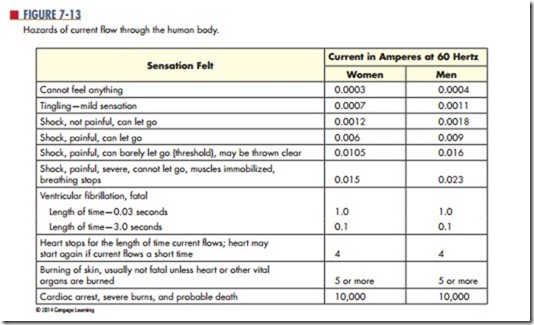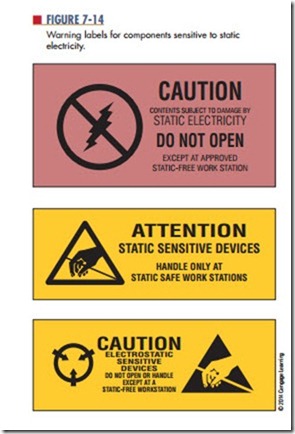safety Practices
Effective safety habits are necessary to succeed in the electronics field. Practicing good safety habits pro- motes a safe work environment. Everyone needs to be aware of and support a safe work environment.
A primary concern in the field of electronics is electrical shock, which is the passage of current through the body. Current can flow through the body just as it does through an electrical circuit. How much current flows depends on these factors:
● Body resistance is high if the skin is dry and there are no cuts or abrasions at the point of electrical contact. This results in little current flow with only a mild shock.
● Body resistance is low if the skin is moist. This results in a high current flow, and if the current flow is through the chest region, the heart can receive a lethal dose of current. The heart may go into fibrillation and breathing may be stopped (Figure 7-13).
Small amounts of current through the body can be dangerous to one’s health. Large amounts of current through the body can be fatal. A shock of 1 to 20 mA can cause a painful sensation. At a shock of approximately 20 to 30 mA, breathing stops. A shock above 100 mA results in electrocution.
The work environment should be reviewed to identify problem areas. Maintaining a safe work environment is easy when you observe the following guidelines:
1. Keep the work area neat and orderly.
2. Be alert and attentive at all times.
3. Know the correct operation and safety procedures of test equipment, tools, and machinery.
4. If an accident occurs, know what action to take.
Personal safety when working with electricity re- quires the following:
● Work with one hand in your back pocket or behind your back when working on live circuits. This technique avoids a complete path for current flow that passes through the heart region.
● Use an isolation transformer when working on AC-powered equipment. The transformer
isolates the powered equipment from the power source.
● Make sure all capacitors are discharged before be- ginning troubleshooting. Use a capacitor discharge tool to discharge the capacitor.
● Use grounded line cords and polarized plugs with AC-operated equipment and circuits. They help to reduce the danger from hot chassis.
● Keep hands off live circuits. Test all circuits with a voltmeter or test lamp before working on them.
Before handling toxic and hazardous chemicals, read the material safety data sheet (MSDS) (Chapter 9) to know the best protection and first-aid procedures in case of emergency. When around these types of chemicals, be concerned about inhaling vapors, swallowing liquids, acid burns on the skin, contact with the eyes, and danger of fire and explosions. Follow these guide- lines to minimize risk:
● Read the labels of all chemicals being used, paying special attention to the printed warnings.
● Work in well-ventilated areas, especially when working with paint and chemical sprays.
● Wear safety glasses when working with hazardous chemicals.
● Wear rubber gloves when working with acids and acid solutions.
● Use tongs or rubber gloves when placing or removing printed circuit boards from the acid solution.
● Clean all tools that contact hazardous chemicals in case anyone accidentally touches them.
Safety is the number-one priority when soldering. Always follow these safety guidelines:
1. Always wear safety glasses when soldering or cut- ting leads. When clipping leads on the printed circuit boards, flying leads can be an eye hazard. When clipping leads, aim down and away from the face and anyone close.
2. Never touch the soldering iron tip or heating element. Only pick up the iron by the handle. Never change the tip when the iron is hot.
3. Beware of fingers slipping over the iron handle and contacting the heating element.
4. Beware of pressing the soldering iron too hard against the leads when heating. The soldering iron may slip.
5. Beware of molten solder dripping from the con- nection. Cotton and wool clothing are the safest to wear when soldering. Many synthetics melt on the skin if molten solder gets splashed on them, causing a greater burn.
6. Use care when handling printed circuit boards.
Leads can cut or puncture the skin. Always have cuts or punctures cleaned and treated immediately.
7. Avoid breathing in flux fumes when soldering.
8. Cleaning solvents dry out the skin. Avoid breathing the vapors.
9. Wash hands before eating or drinking. The lead from the solder remaining on the hands can be ingested with food.
Certain components used on printed circuit boards can be damaged by static electricity referred to as electrostatic discharge (ESD). These static charges are created when nonconductive materials, such as plastic from bags or synthetic materials from clothing, are separated. These charges can be induced on a conductor, such as skin, and are delivered in the form of a spark that passes to another conductor. By touching a printed circuit board or semiconductor device, a static discharge can be delivered through it that may damage a sensitive component or device.
Most static charges that can damage a printed circuit board component or semiconductor device are too weak to feel—less than 3000 volts. Most components of printed circuit board assemblies have warnings, such as the labels shown in Figure 7-14, printed on them, noting that they are sensitive to damage by
static electricity. Keep in mind that just because a component does not have a symbol or label does not mean it is not ESD sensitive.
The following protective guidelines help to prevent damage to components:
● Keep sensitive components enclosed in antistatic bags, boxes, or wraps when not working on them.
● Remove sensitive components from their protective wrapping only when in the antistatic work area.
● Keep antistatic workstations free of static- generating materials such as Styrofoam, plastic desoldering tools, plastic notebook folders, combs, and so on.
Questions
1. Why are safe habits essential when working in the electronics field?
2. What is the primary concern in the field of electronics?
3. How many milliamperes of current through the body will stop a person’s breathing?
4. List procedures that should be observed when working with live electricity.
5. What should be the concern when working around chemicals?
6. List safety guidelines to follow when soldering.
7. List protective measures to prevent ESD damage to components in the work environment.

